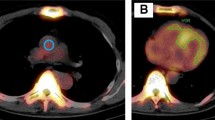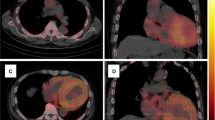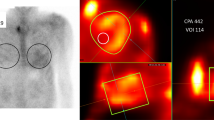Abstract
Background
Quantitation of myocardial 99m Tc-pyrophosphate activity may have high diagnostic accuracy, but its correlation with disease burden is unknown. We examined the relationship between 99m Tc-pyrophosphate quantitation and cardiac magnetic resonance (CMR) measures in patients with suspected transthyretin cardiac amyloidosis (ATTR-CM) or light chain cardiac amyloidosis (AL-CM).
Methods
Consecutive patients who underwent 99mTc-pyrophosphate imaging and CMR were included. ATTR-CM and AL-CM were diagnosed using standard criteria. 99mTc-pyrophosphate images were assessed with standard parameters and quantified with cardiac pyrophosphate activity (CPA) and volume of involvement (VOI). We assessed the association between 99mTc-pyrophosphate image interpretation and CMR tissue characteristics.
Results
Seventy patients were identified, mean age 70.4 ± 11.4 years, with ATTR-CM and AL-CM diagnosed in 22 (31%) and 11 (16%) patients, respectively. In patients with ATTR-CM, there were significant correlations between CPA (r2 = 0.509, P < 0.001) and VOI (r2 = 0.586, P < 0.001) with native myocardial T1 mapping values. Additionally, CPA (adjusted hazard ratio (aHR) 1.04, P = 0.016), VOI (aHR 1.12, P = 0.034), and average myocardial T1 (aHR 1.12, P = 0.025) were associated with incidence of heart failure hospitalization or death.
Conclusion
CPA and VOI were correlated with CMR measures of myocardial fibrosis in patients with ATTR-CM. 99mTc-pyrophosphate quantitation may have a role in ATTR-CM disease staging, guiding treatment, or following response to therapy.




Similar content being viewed by others
Abbreviations
- AL:
-
Light chain cardiac amyloidosis
- CMR:
-
Cardiovascular magnetic resonance
- CPA:
-
Cardiac pyrophosphate activity
- ECV:
-
Extracellular volume
- HCL:
-
Heart/contralateral ratio
- IQR:
-
Interquartile range
- LGE:
-
Late gadolinium enhancement
- LV:
-
Left ventricle
- LVBP:
-
Left ventricular blood pool
- PET:
-
Positron emission tomography
- PSIR:
-
Phase-sensitive inversion recovery
- ROI:
-
Region of interest
- SD:
-
Standard deviation
- SPECT:
-
Single photon emission computed tomography
- Tc:
-
Technetium
- ATTR-CM:
-
Transthyretin cardiac amyloidosis
- VOI:
-
Volume of involvement
References
Ruberg FL, Grogan M, Hanna M, Kelly JW, Maurer MS. Transthyretin amyloid cardiomyopathy: JACC state-of-the-art review. J Am Coll Cardiol 2019;73:2872‐91.
Falk RH, Alexander KM, Liao R, Dorbala S. AL (light-chain) cardiac amyloidosis: A review of diagnosis and therapy. J Am Coll Cardiol 2016;68:1323‐41.
Dorbala S, Ando Y, Bokhari S, Dispenzieri A, Falk RH, Ferrari VA. ASNC/AHA/ASE/EANM/HFSA/ISA/SCMR/SNMMI expert consensus recommendations for multimodality imaging in cardiac amyloidosis: Part 1 of 2-evidence base and standardized methods of imaging. J Card Fail 2019;25:e1‐39.
Bokhari S, Castano A, Pozniakoff T, Deslisle S, Latif F, Maurer MS. (99m)Tc-pyrophosphate scintigraphy for differentiating light-chain cardiac amyloidosis from the transthyretin-related familial and senile cardiac amyloidoses. Circ Cardiovasc Imaging 2013;6:195‐201.
Sperry BW, Burgett E, Bybee KA, McGhie AI, O’Keefe JH, Saeed IM, et al. Technetium pyrophosphate nuclear scintigraphy for cardiac amyloidosis: Imaging at 1 vs 3 hours and planar vs SPECT/CT. J Nucl Cardiol 2020;27:1802‐7.
Miller R, Cadet S, Mah D, Pournazari P, Chan D, Fine N et al. Diagnostic and Prognostic Value of Technetium-99m Pyrophosphate Uptake Quantitation for Transthyretin Cardiac Amyloidosis. J Nucl Cardiol 2020 (In press).
Caobelli F, Braun M, Haaf P, Wild D, Zellweger MJ. Quantitative (99m)Tc-DPD SPECT/CT in patients with suspected ATTR cardiac amyloidosis: Feasibility and correlation with visual scores. J Nucl Cardiol 2020;27:1456‐63.
Ramsay SC, Cuscaden C. The current status of quantitative SPECT/CT in the assessment of transthyretin cardiac amyloidosis. J Nucl Cardiol 2020;27:1464‐8.
Fontana M, Pica S, Reant P, Abdel-Gadir A, Treibel TA, Banypersad SM, et al. Prognostic value of late gadolinium enhancement cardiovascular magnetic resonance in cardiac amyloidosis. Circulation 2015;132:1570‐9.
Hur DJ, Dicks DL, Huber S, Mojibian HR, Meadows JL, Seropian SE, et al. Serial native T1 mapping to monitor cardiac response to treatment in light-chain amyloidosis. Circ Cardiovasc Imaging 2016;9:e004770.
Pan JA, Kerwin MJ, Salerno M. Native T1 mapping, extracellular volume mapping, and late gadolinium enhancement in cardiac amyloidosis: A meta-analysis. JACC Cardiovasc Imaging 2020;13:1299‐310.
Kyriakou P, Mouselimis D, Tsarouchas A, Rigopoulos A, Bakogiannis C, Noutsias M, et al. Diagnosis of cardiac amyloidosis: A systematic review on the role of imaging and biomarkers. BMC Cardiovasc Disord 2018;18:221.
Gillmore JD, Maurer MS, Falk RH, Merlini G, Damy T, Dispenzieri A, et al. Nonbiopsy diagnosis of cardiac transthyretin amyloidosis. Circulation 2016;133:2404‐12.
Ahmadian A, Brogan A, Berman J, Sverdlov AL, Mercier G, Mazzini M, et al. Quantitative interpretation of FDG PET/CT with myocardial perfusion imaging increases diagnostic information in the evaluation of cardiac sarcoidosis. J Nucl Cardiol 2014;21:925‐39.
Miller RJH, Cadet S, Pournazari P, Pope A, Kransdorf E, Hamilton MA et al. Quantitative Assessment of Cardiac Hypermetabolism and Perfusion for Diagnosis of Cardiac Sarcoidosis. J Nucl Cardiol 2020. (in press).
Nacif MS, Turkbey EB, Gai N, Nazarian S, van der Geest RJ, Noureldin RA, et al. Myocardial T1 mapping with MRI: Comparison of look-locker and MOLLI sequences. J Magn Reson Imaging 2011;34:1367‐73.
Fontana M, Pica S, Reant P, Abdel-Gadir A, Treibel TA, Banypersad SM, et al. LGE-PSIR is an independent predictor of mortality in cardiac amyloidosis: a 250 patient prospective study. J Cardiovasc Magn Reson 2015;17:O27-O.
Cerqueira MD, Weissman NJ, Dilsizian V, Jacobs AK, Kaul S, Laskey WK, et al. Standardized myocardial segmentation and nomenclature for tomographic imaging of the heart. A statement for healthcare professionals from the Cardiac Imaging Committee of the Council on Clinical Cardiology of the American Heart Association. Circulation 2002;105:539‐42.
Fine NM, Tandon S, Kim HW, Shah DJ, Thompson T, Drangova M, et al. Validation of sub-segmental visual scoring for the quantification of ischemic and nonischemic myocardial fibrosis using late gadolinium enhancement MRI. J Magn Reson Imaging 2013;38:1369‐76.
Haaf P, Garg P, Messroghli DR, Broadbent DA, Greenwood JP, Plein S. Cardiac T1 mapping and extracellular volume (ECV) in clinical practice: A comprehensive review. J Cardiovasc Magn Reson 2016;18:89.
Southern DA, Norris CM, Quan H, Shrive FM, Galbraith PD, Humphries K, et al. An administrative data merging solution for dealing with missing data in a clinical registry: Adaptation from ICD-9 to ICD-10. BMC Med Res Methodol 2008;8:1.
Hicks KA, Tcheng JE, Bozkurt B, Chaitman BR, Cutlip DE, Farb A, et al. 2014 ACC/AHA key data elements and definitions for cardiovascular endpoint events in clinical trials. J Am Coll Cardiol 2015;66:403‐69.
Maurer MS, Schwartz JH, Gundapaneni B, Elliott PM, Merlini G, Waddington-Cruz M, et al. Tafamidis treatment for patients with transthyretin amyloid cardiomyopathy. N Engl J Med 2018;379:1007‐16.
Solomon SD, Adams D, Kristen A, Grogan M, Gonzalez-Duarte A, Maurer MS, et al. Effects of patisiran, an RNA interference therapeutic, on cardiac parameters in patients with hereditary transthyretin-mediated amyloidosis. Circulation 2019;139:431‐43.
Castano A, Haq M, Narotsky DL, Goldsmith J, Weinberg RL, Morgenstern R, et al. Multicenter study of planar technetium 99m pyrophosphate cardiac imaging: Predicting survival for patients with ATTR cardiac amyloidosis. JAMA Cardiol 2016;1:880‐9.
Perugini E, Guidalotti PL, Salvi F, Cooke RM, Pettinato C, Riva L, et al. Noninvasive etiologic diagnosis of cardiac amyloidosis using 99mTc-3,3-diphosphono-1,2-propanodicarboxylic acid scintigraphy. J Am Coll Cardiol 2005;46:1076‐84.
Dorbala S, Ando Y, Bokhari S, Dispenzieri A, Falk RH, Ferrari VA, et al. ASNC/AHA/ASE/EANM/HFSA/ISA/SCMR/SNMMI expert consensus recommendations for multimodality imaging in cardiac amyloidosis: Part 2 of 2-Diagnostic criteria and appropriate utilization. J Nucl Cardiol 2020;27:659‐73.
Sikanderkhel S, Liu YH, Liu C, Miller E. Suv quantification of 99mtc-Pyp imaging in Ttr-cardiac amyloidosis using a Czt camera: A new tool in the armamentarium. J Am Coll Cardiol 2018;71:1689.
Glaudemans AW, van Rheenen RW, van den Berg MP, Noordzij W, Koole M, Blokzijl H, et al. Bone scintigraphy with (99m)technetium-hydroxymethylene diphosphonate allows early diagnosis of cardiac involvement in patients with transthyretin-derived systemic amyloidosis. Amyloid 2014;21:35‐44.
Dorbala S, Park MA, Cuddy S, Singh V, Sullivan K, Kim S, et al. Absolute quantitation of cardiac (99m)Tc-pyrophosphate using cadmium zinc telluride-based SPECT/CT. J Nucl Med 2020;62:716‐22.
Morioka M, Takashio S, Nishi M, Tsujita K. Abstract 12230: Correlation of technetium pyrophosphate uptake with cardiac amyloid load, native T1, and extracellular volume in patients with transthyretin cardiac amyloidosis. Circulation 2019;140:A12230-A.
Fontana M, Martinez-Naharro A, Chacko L, Rowczenio D, Gilbertson JA, Whelan CJ, et al. Reduction in CMR derived extracellular volume with patisiran indicates cardiac amyloid regression. JACC Cardiovasc Imaging 2021;14:189‐99.
Kholová I, Niessen HWM. Amyloid in the cardiovascular system: A review. J Clin Pathol 2005;58:125‐33.
Martinez-Naharro A, Kotecha T, Norrington K, Boldrini M, Rezk T, Quarta C, et al. Native T1 and extracellular volume in transthyretin amyloidosis. JACC Cardiovasc Imaging 2019;12:810‐9.
Boynton SJ, Geske JB, Dispenzieri A, Syed IS, Hanson TJ, Grogan M, et al. LGE provides incremental prognostic information over serum biomarkers in AL cardiac amyloidosis. JACC Cardiovasc Imaging 2016;9:680‐6.
Grogan M, Scott CG, Kyle RA, Zeldenrust SR, Gertz MA, Lin G, et al. Natural history of wild-type transthyretin cardiac amyloidosis and risk stratification using a novel staging system. J Am Coll Cardiol 2016;68:1014‐20.
Maurer MS. Noninvasive identification of ATTRwt cardiac amyloid: The re-emergence of nuclear cardiology. Am J Med 2015;128:1275‐80.
Kircher M, Ihne S, Brumberg J, Morbach C, Knop S, Kortum KM, et al. Detection of cardiac amyloidosis with (18)F-Florbetaben-PET/CT in comparison to echocardiography, cardiac MRI and DPD-scintigraphy. Eur J Nucl Med Mol Imaging 2019;46:1407‐16.
Manwani R, Page J, Lane T, Burniston M, Skillen A, Lachmann HJ, et al. A pilot study demonstrating cardiac uptake with 18F-florbetapir PET in AL amyloidosis patients with cardiac involvement. Amyloid 2018;25:247‐52.
Cuddy SAM, Bravo PE, Falk RH, El-Sady S, Kijewski MF, Park MA, et al. Improved quantification of cardiac amyloid burden in systemic light chain amyloidosis: Redefining early disease? JACC Cardiovasc Imaging 2020;13:1325‐36.
Masri A, Bukhari S, Ahmad S, Nieves R, Eisele YS, Follansbee W, et al. Efficient 1-hour technetium-99 m pyrophosphate imaging protocol for the diagnosis of transthyretin cardiac amyloidosis. Circ Cardiovasc Imaging 2020;13:e010249.
Musumeci M, Cappelli F, Russo D, Tini G, Canepa M, Milandri A, et al. Low sensitivity of bone scintigraphy in detecting Phe64Leu mutation-related transthyretin cardiac amyloidosis. JACC Cardiovasc Imaging 2020;13:1314‐21.
Castaño A, DeLuca A, Weinberg R, Pozniakoff T, Blaner WS, Pirmohamed A, et al. Serial scanning with technetium pyrophosphate ((99m)Tc-PYP) in advanced ATTR cardiac amyloidosis. J Nucl Cardiol 2016;23:1355‐63.
Scully PR, Morris E, Patel KP, Treibel TA, Burniston M, Klotz E, et al. DPD quantification in cardiac amyloidosis: A novel imaging biomarker. JACC Cardiovasc Imaging 2020;13:1353‐63.
Acknowledgments
None
Disclosures
This research was supported in part by NIH Grant R01-HL135557. Dr. Fine reports research and consulting support from Pfizer, Akcea, Ionis, Alnylam, and Eidos. Dr. White receives funding from the Calgary Health Trust and Siemens Healthineers and is a shareholder in Cohesic Inc. Dr. Miller reports consulting support from Alnylam and Pfizer. The other authors have no other relevant disclosures.
Author information
Authors and Affiliations
Corresponding author
Additional information
Publisher's Note
Springer Nature remains neutral with regard to jurisdictional claims in published maps and institutional affiliations.
The authors of this article have provided a PowerPoint file, available for download at SpringerLink, which summarizes the contents of the paper and is free for re-use at meetings and presentations. Search for the article DOI on SpringerLink.com.
Funding
This research was supported in part by NIH Grant R01-HL135557.
Supplementary Information
Below is the link to the electronic supplementary material.
Rights and permissions
About this article
Cite this article
Roshankar, G., White, G.C., Cadet, S. et al. Quantitative technetium pyrophosphate and cardiovascular magnetic resonance in patients with suspected cardiac amyloidosis. J. Nucl. Cardiol. 29, 2679–2690 (2022). https://doi.org/10.1007/s12350-021-02806-4
Received:
Accepted:
Published:
Issue Date:
DOI: https://doi.org/10.1007/s12350-021-02806-4




